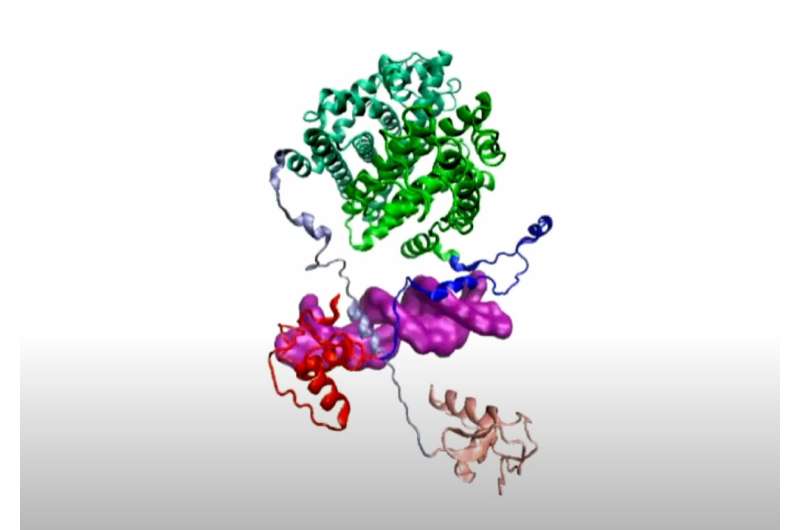This article has been reviewed according to Science X's editorial process and policies. Editors have highlighted the following attributes while ensuring the content's credibility:
fact-checked
peer-reviewed publication
trusted source
proofread
Researchers uncover dynamics behind protein crucial in breast cancer

Watching a puppet show can teach you something about how estrogen works in the body, according to Rice University scientists whose research could open the door to new strategies for regulating the hormone—which could help prevent breast cancer and other diseases.
Just as a puppeteer manipulates strings, an estrogen receptor , once it binds to a hormone molecule, manipulates its structure to access a specific DNA site, where it will either enhance or inhibit gene expression. Estrogen receptors play a crucial role in breast cancer, making them therapeutic targets for tumor growth inhibition.
A study published this week in the Proceedings of the National Academy of Sciences explains the link between the particular structure of estrogen receptor alpha proteins and how these receptors function at the molecular level.
"This molecule has two regions or domains that normally are not touching each other," said Rice theoretical physicist Peter Wolynes , the study's corresponding author. "Instead, they're separated by two stringlike structures. The puzzle was, how do these two domains communicate with each other? How is the information that a hormone is bound conveyed to the domain that binds DNA?"
Using software called AWSEM that his research group developed to predict the structure and dynamics of proteins, Wolynes and his team of Rice graduate students found estrogen receptor hormone regulation is controlled by a previously unknown strategy of molecular communication.
"For most of my career, the dominant viewpoint about how protein molecules function has been that they're fairly rigid objects and that their molecular mechanics involved interactions like those in simple machines, using levers and hinges. So, it's very weird when you have these stringy structures because they don't seem to work like that," Wolynes said.
Wolynes' previous research uncovered that stringlike protein structures can act like the arms of an octopus.
"This stringy octopus' arm finds something, grabs onto it and then organizes itself," he said. "That's a mechanism we discovered a long time ago that we called fly-casting. It has been seen in many systems."
In the case of the estrogen receptor protein, the fact that the different areas of the molecule are connected by two stringlike structures made it difficult to account for how the region of the molecule that binds to the hormone, known as the ligand binding domain, communicates with the region of the molecule that attaches to the DNA, or the DNA binding domain.
"By doing a simulation of the dynamics of the molecule, what we discovered was that when the ligand binding domain changed its structure, it rotated and moved the strings a little bit farther apart. In so doing, it shortened the strings connecting it to the other domain, bringing it into closer contact with the DNA. This is like the way a puppet master would manipulate a marionette," Wolynes said.
"To our knowledge, no one has ever thought about this idea that the two strings basically cooperated with each other to work like a marionette," he added.
Estrogen receptor mutations are linked to numerous other diseases and types of cancer besides breast cancer.
"It turns out that some of the mutations that disable the estrogen receptor in cancers occur exactly in this hinge region," he said of the region composed of the stringlike structures. "That is something that we now can begin to analyze. We think it'll give insight to the people who work on the pharmacology side about why that region in the estrogen receptor is disabled in some cases and not in others."
Wolynes said the finding could help reshape understanding of how hormone receptor molecules work more broadly.
"We think that this may be a very common functional mechanism in protein dynamics," Wolynes said. "There are a lot of other hormone receptors that have a similar organization of structured domains connected by strings."
The question of protein structure prediction, sometimes called the protein folding problem, has garnered a lot of attention in recent years due to the development of AlphaFold, a system by Google AI offshoot DeepMind that predicts the 3D structure of proteins based on their amino acid sequence.
Wolynes said that while AlphaFold focuses on predicting the particular shape into which a protein will fold, while AWSEM, developed and maintained by his research group at Rice and by the laboratory of University of Maryland chemist Garegin Papoian, predicts both a protein's folded shape and how it will behave and interact within its molecular environment.
"We also did quite well in the famous Critical Assessment of Protein Structure Prediction , or CASP, contest that AlphaFold did so well in," Wolynes said of AWSEM's abilities.
More information: Chen, Xun et al, The marionette mechanism of domain–domain communication in the antagonist, agonist, and coactivator responses of the estrogen receptor, Proceedings of the National Academy of Sciences (2023). DOI: 10.1073/pnas.2216906120. doi.org/10.1073/pnas.2216906120
Journal information: Proceedings of the National Academy of Sciences
Provided by Rice University




















